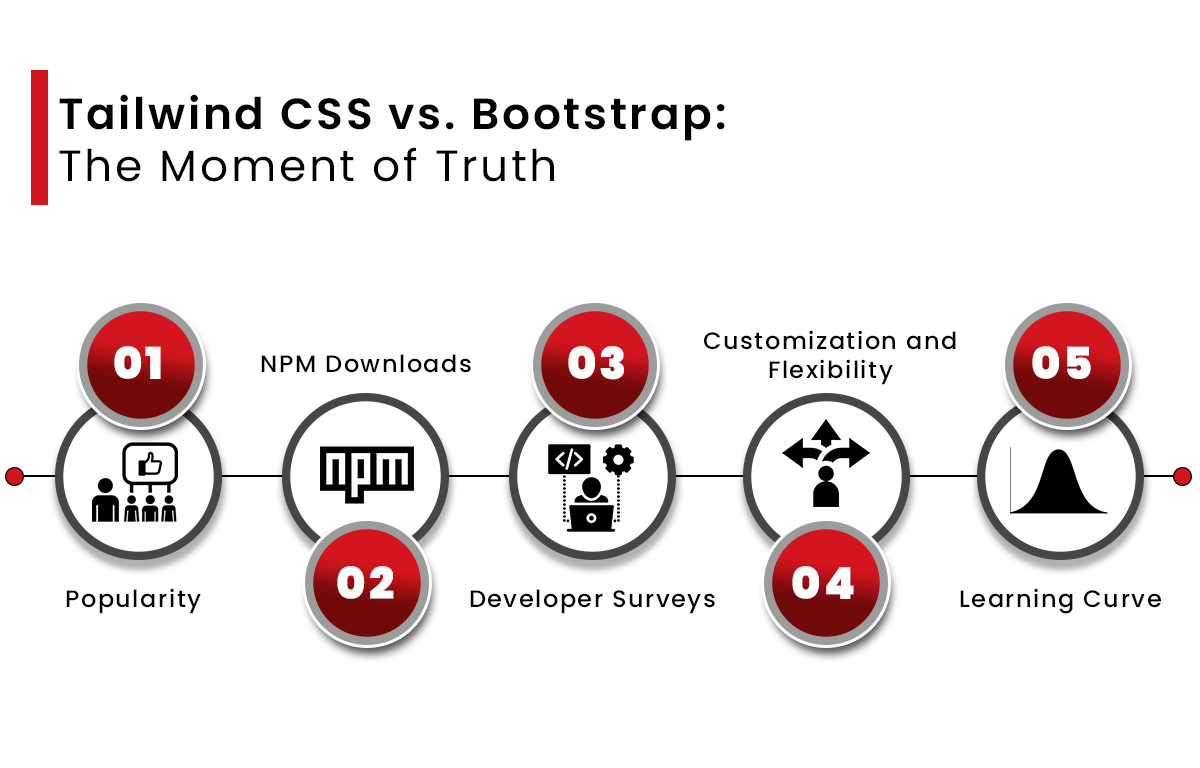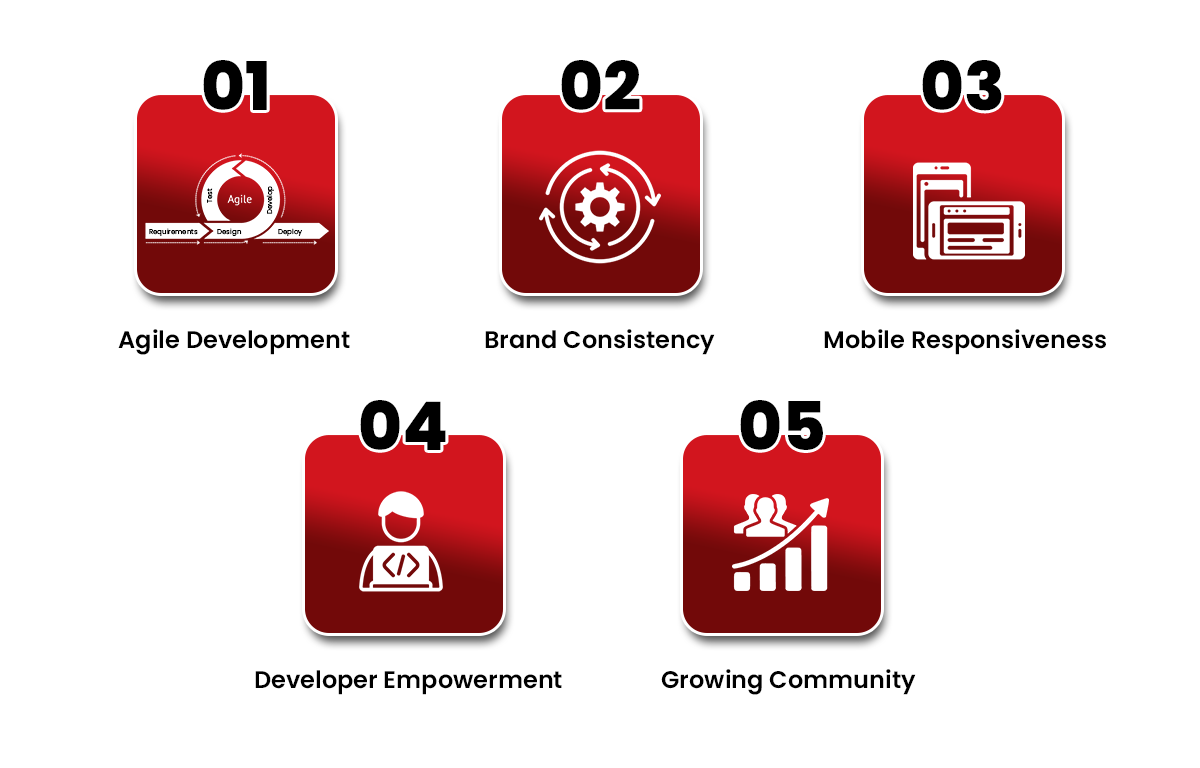In the ever-evolving world of web development, the battle for supremacy rages on between two heavyweight contenders: Tailwind CSS and Bootstrap. Each brings a unique set of features and benefits, captivating developers globally. As of 2024, recent statistics indicate a fascinating shift in the tide.
Tailwind CSS is mostly used by companies located in the United States, primarily within the Information Technology and Services sector. It is most commonly adopted by businesses with a workforce ranging from ten to fifty employees and annual revenue between one and ten million dollars.
Tailwind CSS has surged ahead, witnessing an exponential rise in adoption, with over 40% of developers expressing a preference for its utility-first approach and customizable nature. Meanwhile, Bootstrap, once the undisputed champion, remains a formidable player with a dedicated user base and widespread integration.
Join us as we explore the current scenario, delve into the prowess of these frameworks, and discover who claims the throne of relevance today.
What is Tailwind CSS?
Tailwind CSS is a popular and highly customizable CSS framework designed for building modern and responsive user interfaces. Unlike traditional frameworks that come with pre-defined classes, Tailwind CSS adopts a utility-first approach, providing a vast collection of small utility classes that can be combined to create tailored styles.
This unique approach grants developers unparalleled flexibility and allows them to craft designs precisely to their specifications without writing custom CSS. With its modular and intuitive syntax, Tailwind CSS streamlines the development process, leading to faster and more efficient coding. Its growing community and extensive documentation make it a favored choice among web developers seeking a highly versatile CSS framework.
Features of Tailwind CSS?
Tailwind CSS comes packed with a plethora of features that empower developers to create robust and visually appealing user interfaces. Some of its notable features include:
Utility-first approach
Tailwind CSS offers a wide array of utility classes, allowing developers to apply styles directly in the markup, making customization quick and convenient.
Customizable
Developers can easily customize the default design system and create their own design tokens to ensure brand consistency and a unique look.
Responsive design
Tailwind CSS includes responsive utility classes, enabling the creation of mobile-friendly and adaptive layouts effortlessly.
Flexbox and Grid support
Built-in flexbox and grid utilities facilitate the creation of complex layouts without the need for additional CSS.
Dark mode support
Tailwind CSS provides utilities to enable and customize dark mode for websites and applications.
Theming
With its theme configuration, developers can change color schemes and styles consistently throughout the project.
PurgeCSS integration
Tailwind CSS can be combined with PurgeCSS to remove unused CSS, leading to smaller file sizes and faster loading of websites.
Active community
The framework has a thriving community that continuously contributes plugins, extensions, and resources to enhance its capabilities.
Tailwind CSS vs. Bootstrap: The Moment of Truth

As of the current scenario, the relevance of Tailwind CSS and Bootstrap can be evaluated based on various factors and statistics:
Popularity
In 2024, Tailwind CSS has witnessed a remarkable increase in popularity and usage among developers globally. While Bootstrap remains a prevalent framework, its growth rate has been comparatively slower than that of Tailwind CSS.
GitHub Stars
As of the latest data, Tailwind CSS has garnered a substantial number of stars on GitHub, signifying its growing community support and engagement.
Bootstrap, being an older framework, has already amassed a considerable number of stars but might not be experiencing the same rapid growth.
NPM Downloads
Tailwind CSS has witnessed a remarkable increase in downloads on npm, reflecting its increasing preference among developers.
Bootstrap continues to enjoy a strong presence on npm, but its download rate may not be as high as that of Tailwind CSS.
Developer Surveys
In recent developer surveys, Tailwind CSS has gained momentum, with a growing number of respondents expressing their preference for its utility-first approach and customization capabilities.
Bootstrap, having been a dominant framework for a long time, may still have a large user base, but its popularity may have plateaued.
Customization and Flexibility
Tailwind CSS excels in customization and flexibility due to its utility-first approach, allowing developers to create unique designs effortlessly.
Bootstrap offers a more structured and opinionated approach, which might not suit projects requiring extensive customization.
Learning Curve
Tailwind CSS's utility classes make it easier for developers to learn and use, reducing the learning curve and speeding up the development process.
Bootstrap, with its predefined components and CSS classes, might be more straightforward for beginners, but it could be limiting for experienced developers seeking more granular control.
Tailwind CSS vs. Bootstrap: A Comparative Table
|
Feature |
Tailwind CSS |
Bootstrap |
|
Approach |
Utility-first |
Component-based |
|
Customization |
Highly customizable |
Less customizable |
|
Core Features |
Minimalistic |
Extensive |
|
Learning Curve |
Steeper |
Shallower |
|
Performance |
Generally better (due to minimal core) |
Can be optimized but might be less performant out of the box |
|
Community Support |
Growing rapidly |
Large and established |
|
Ideal Use Cases |
Custom-designed, performant websites |
Rapid prototyping, consistent interfaces |
|
Common Use Cases |
E-commerce, SaaS, landing pages |
Dashboards, admin panels, corporate websites |
So, we can conclude, that Tailwind CSS has emerged as a highly relevant and popular framework in the current scenario, boasting an expanding community, growing GitHub stars, and increasing NPM downloads. Its utility-first approach, customization options, and flexibility have resonated with developers, making it a strong contender in the modern web development landscape.
However, Bootstrap remains relevant and widely used, particularly for projects that require a faster setup or are comfortable with its predefined components and design patterns. Ultimately, the choice between the two depends on the specific needs and preferences of the development team.
When to Choose Tailwind for Your Business


It is very important that you need to understand when to use the right technologies for your business. Here are a few scenarios that you should consider while choosing Tailwind CSS for your business:
• Agile Development: Choose Tailwind CSS for your business if you value agility and rapid development. Its utility-first approach accelerates the coding process, allowing your team to iterate and deploy faster.
• Brand Consistency: Tailwind empowers you to maintain a strong and consistent brand identity. Customize your UI with precision to match your brand colors and styles flawlessly.
• Mobile Responsiveness: With built-in responsive design utilities, Tailwind ensures your website or application looks stunning and functions seamlessly across various devices.
• Developer Empowerment: Tailwind's intuitive syntax and modular design inspire creativity and productivity, empowering your developers to push boundaries and deliver exceptional user experiences.
• Growing Community: Join a vibrant community of developers and designers who actively contribute to plugins, resources, and support, fueling your business's success.
Embrace Tailwind CSS and transform your web development into a captivating and efficient journey.
Thoughts About Vanilla CSS in 2024?
While CSS frameworks abstract away the complexities of writing CSS, enabling developers to focus on building and styling, they might not be the only solution. In fact, embracing vanilla CSS can offer developers greater creative control and precision in crafting unique designs.
However, it's undeniable that CSS frameworks have their merits. According to recent developer surveys, Tailwind CSS has experienced significant growth, with a substantial increase in adoption rates and community support. These frameworks offer efficiency gains and streamline workflows, making them valuable assets for scaling projects and boosting productivity.
Ultimately, the choice between using a CSS framework or vanilla CSS depends on the project's specific requirements, the development team's expertise, and the desired level of customization and control. Balancing the benefits of both approaches will pave the way for building exceptional websites and user interfaces that leave a lasting impact.
Technology Zenesys Works on
Apart from hefting you with the best technological solutions, our experts will also provide you with consultation. It will help you to make the right choice for your business. Leveraging new technologies for business is good and fruitful but it is essential to analyze when to use what.

Conclusion
On the other hand, Bootstrap remains relevant with its prebuilt components and easy-to-use design patterns, appealing to those looking for a quicker setup and simpler workflow.
Ultimately, the relevance of each framework depends on the specific needs of your project. If rapid development, creative control, and customization are paramount, Tailwind CSS shines as a powerful contender. Conversely, if you prioritize a tried-and-tested framework with a straightforward approach, Bootstrap may be the right fit.
In conclusion, both Tailwind CSS and Bootstrap hold their ground as relevant players in the web development arena. Choosing the most suitable framework hinges on striking the perfect balance between customization and ease of use, ensuring your projects stand out in the dynamic and ever-evolving digital world.
Frequently Asked Questions
Tailwind CSS is a must-have in modern web development. Once learned, it becomes indispensable for every project, offering speed, consistency, and customization to web designers. Its utility-first approach empowers developers to streamline workflows and create exceptional designs, making it an invaluable tool in the dynamic world of web development.
Which CSS framework offers better customization capabilities?
Tailwind CSS is known for its extensive customization options, allowing developers to create unique designs with precision. Bootstrap, while customizable, follows a more opinionated approach, which might limit extensive customization.
Are there any performance differences between Tailwind CSS and Bootstrap?
Both frameworks aim to optimize performance, but Tailwind CSS's utility-first approach allows developers to reduce CSS file sizes by including only the classes needed. This often leads to smaller file sizes and improved performance.
Which framework has a more active community for ongoing support?
Both frameworks have active communities, but as of now, Tailwind CSS has seen a significant surge in community engagement, with developers contributing plugins, extensions, and resources, making it a robust and supported choice for web development.
Which Technology can Zenesys help?
Both we can help with both the technology and aid you with suitable solutions. We believe in updating ourselves according to the current scenarios and trends.


.webp?lang=en-US&ext=.webp)

.webp?lang=en-US&ext=.webp)

